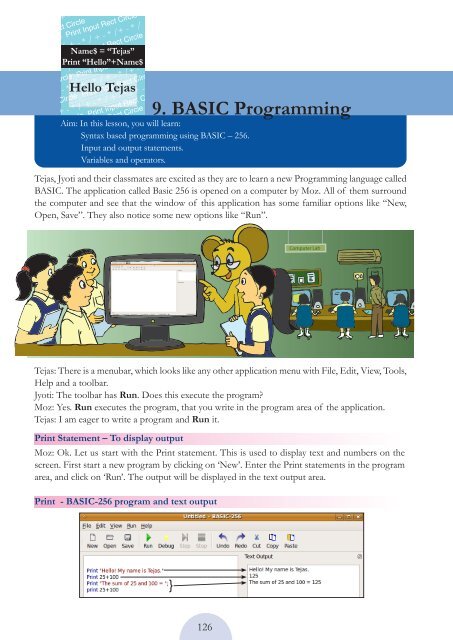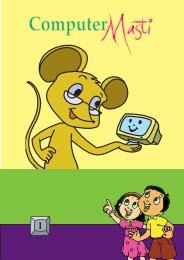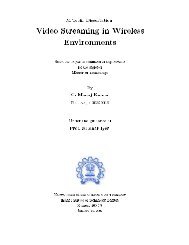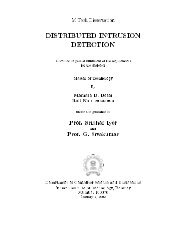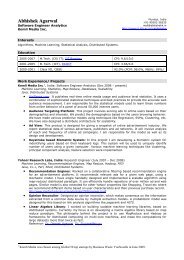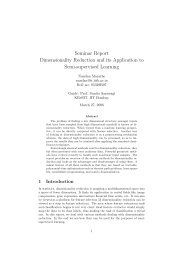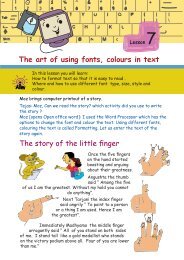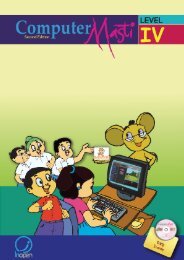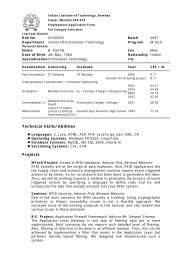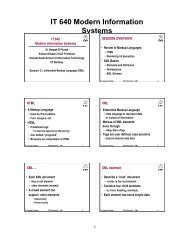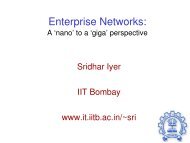9. BASIC Programming
9. BASIC Programming
9. BASIC Programming
You also want an ePaper? Increase the reach of your titles
YUMPU automatically turns print PDFs into web optimized ePapers that Google loves.
+ - /<br />
ct Circle<br />
e Print Input Rect Circle<br />
/<br />
cle<br />
* /<br />
+ - * / + - * /+ - * /<br />
Name$ = “Tejas”<br />
Print “Hello”+Name$<br />
Print Input Rect Circle<br />
+ - * / + - * /+ - * /<br />
ircle<br />
e<br />
Print Input Rect Circle<br />
Hello Tejas<br />
- *<br />
/<br />
+ - * / + - */+<br />
- *<br />
Circle<br />
Print Input Rect Circ<br />
+ - * */<br />
+<br />
- * / + - * /+ + -<br />
/<br />
cle Print t Input<br />
Rectt<br />
Ci<br />
Rect Circle<br />
<strong>9.</strong> <strong>BASIC</strong> <strong>Programming</strong><br />
Aim: In this lesson, you will learn:<br />
Syntax based programming using <strong>BASIC</strong> – 256.<br />
Input and output statements.<br />
Variables and operators.<br />
Tejas, Jyoti and their classmates are excited as they are to learn a new <strong>Programming</strong> language called<br />
<strong>BASIC</strong>. The application called Basic 256 is opened on a computer by Moz. All of them surround<br />
the computer and see that the window of this application has some familiar options like “New,<br />
Open, Save”. They also notice some new options like “Run”.<br />
Computer Lab<br />
Tejas: There is a menubar, which looks like any other application menu with File, Edit, View, Tools,<br />
Help and a toolbar.<br />
Jyoti: The toolbar has Run. Does this execute the program?<br />
Moz: Yes. Run executes the program, that you write in the program area of the application.<br />
Tejas: I am eager to write a program and Run it.<br />
Print Statement – To display output<br />
Moz: Ok. Let us start with the Print statement. This is used to display text and numbers on the<br />
screen. First start a new program by clicking on ‘New’. Enter the Print statements in the program<br />
area, and click on ‘Run’. The output will be displayed in the text output area.<br />
Print - <strong>BASIC</strong>-256 program and text output<br />
}<br />
126
Jyoti: In the first statement, Print is displaying text which is inside quotes.<br />
Moz: This is called a String.<br />
Tejas: In the second statement, Print is printing the sum of the two numbers. This means the two<br />
numbers are added and then the result is printed.<br />
Jyoti: The output of third Print statement and fourth print statement are on the same line. Is it<br />
because of the ‘;’ at the end of the Print statement?<br />
Moz: You are right. You have explained the syntax of Print statements.<br />
Syntax of a programming language<br />
Concept<br />
• Syntax of a programming language is the set of rules that specifies<br />
the grammar of the programming language.<br />
• Without syntax a program will only be a set of words without any<br />
structure.<br />
Print statement<br />
Info<br />
Syntax: Print expression<br />
Print expression ;<br />
• The print statement is used to display<br />
text and numbers on the text output<br />
area.<br />
• Print followed by Text, numbers and<br />
other symbols (ex: *, &, ^, % etc.)<br />
enclosed “ ” (in quotes) are displayed as<br />
they are entered.<br />
• Print followed by arithmetic expressions<br />
(ex: addition, multiplication, division<br />
etc.) are evaluated and the result is<br />
displayed.<br />
• For getting output of several print<br />
statements on the same line, use a ‘;’<br />
(semicolon) at the end of each Print<br />
statement.<br />
<strong>BASIC</strong>-256 Example and Text output<br />
PROGRAM<br />
PROGRAM<br />
PROGRAM<br />
PROGRAM<br />
Print “My name is Jyoti. I am<br />
12 years old.”<br />
My name is Jyoti. I am 12<br />
years old. 125<br />
Print “Sum of 100 + 75=” Sum of 100 + 75=<br />
Print 100 + 75 175<br />
Print “Sum of 100 + 75=”;<br />
Print 100 + 75<br />
125<br />
125<br />
Sum of 100 + 75=175<br />
125<br />
OUTPUT<br />
OUTPUT<br />
OUTPUT<br />
OUTPUT<br />
Moz: Now that you have understood the Print statement, go ahead and try out some more Print<br />
statements.<br />
Tejas: Should we start a new program?<br />
Moz: It is not necessary. You can add more statements and run the same program or you can start<br />
a new program. You can also save programs (using Save) and load a saved program later (using<br />
Open).<br />
To execute a program<br />
or an instruction<br />
To locate and<br />
remove errors<br />
To stop the execution<br />
of a program<br />
To execute<br />
instructions<br />
one by one<br />
127
Arithmetic expressions<br />
Tejas: I want to include division and multiplication in my statements. Which is the division symbol<br />
on keyboard?<br />
Moz: Use ‘/’ for division and use ‘*’ for multiplication. These are the symbols used for division and<br />
multiplication in many programming languages.<br />
Tejas: Can we also use brackets like we do in Maths.<br />
Moz: Yes. You can. The order of operations is also exactly the way you do in Maths, i.e.,<br />
BODMAS.<br />
B Brackets first<br />
O Orders (ie Powers and Square Roots, etc.)<br />
DM Division and Multiplication (left-to-right)<br />
AS Addition and Subtraction (left-to-right)<br />
PROGRAM<br />
Print “ Average of 50, 68, 35 = ”;<br />
Print (50+68+35) / 3<br />
Print “The cost of an apple = Rs.13”<br />
Print “The cost of 12 apples = Rs. “;<br />
Print 13*12<br />
Jyoti: In the statement Print (50+68+35)/3, BODMAS rule is used to evaluate the arithmetic<br />
expression and then the result is displayed.<br />
Arithmetic operators<br />
Average of 50, 68, 35 = 51<br />
The cost of an apple = Rs.13<br />
The cost of 12 apples = Rs.156<br />
OUTPUT<br />
Arithmetic operation Operator <strong>BASIC</strong>-256 Example and Text output<br />
Addition +<br />
Print 256 + 567 + 678 1501<br />
PROGRAM<br />
OUTPUT<br />
Subtraction -<br />
PROGRAM<br />
Print 1000 - 750 250<br />
OUTPUT<br />
Info<br />
Multiplication *<br />
PROGRAM<br />
Print 250 * 20 5000<br />
OUTPUT<br />
Division /<br />
PROGRAM<br />
Print 135 / 9 15<br />
OUTPUT<br />
Multiple operators<br />
PROGRAM<br />
Print 250 + (250 - 100) *<br />
20 / 5<br />
850<br />
OUTPUT<br />
Moz: Now try out these statements.<br />
PROGRAM<br />
Print “Jyoti and Tejas”+ “are<br />
learning <strong>BASIC</strong>”<br />
Jyoti and Tejas are learning<br />
<strong>BASIC</strong><br />
OUTPUT<br />
PROGRAM<br />
Print “Today the price of<br />
12 apples is = Rs.” + (5 * 12)<br />
Today the price of 12 apples<br />
is = Rs.60<br />
OUTPUT<br />
PROGRAM<br />
Print “The area of a rectangle of<br />
length 12 units and breadth 8<br />
units = “+ (12 * 8) + “square units”<br />
The area of a rectangle of length<br />
12 units and breadth 8 units =<br />
96square units<br />
OUTPUT<br />
128
Tejas: In these statements, phrases (strings) are combined to get a full sentence.<br />
Jyoti: In the second statement, the price of 12 apples is calculated and then printed.<br />
Moz: The ‘+’ operator also adds strings together. This operation is called concatenation. In<br />
concatenation, two or more strings are joined together, to make a longer string.<br />
String operation<br />
Info<br />
String operation Operator <strong>BASIC</strong>-256 Example and Text output<br />
Concatenation +<br />
PROGRAM<br />
Print “I have apples ” + “and oranges.”<br />
Print “Price of 20 books = Rs.” + (25*20)<br />
I have apples and oranges.<br />
Price of 20 books = Rs.500<br />
OUTPUT<br />
Variables - Numeric Variables – To store numeric values<br />
Jyoti: Let us convert the addition flowchart into a program.<br />
Start<br />
Read A<br />
Read B<br />
Sum = A + B<br />
Print Sum<br />
End<br />
Moz: Use the example values where A = 346 and B = 478<br />
PROGRAM<br />
A = 346<br />
B = 478<br />
Sum = A + B<br />
Print “ Sum of A + B = ”;<br />
Print Sum<br />
Sum of A + B = 824<br />
125<br />
OUTPUT<br />
Moz: What are you instructing the computer in the first and second statements.<br />
PROGRAM<br />
Jyoti: The first statement is instructing the computer to store 346 in a variable named A. The<br />
second instruction similarly instructs the computer to store 478 in a variable named B.<br />
PROGRAM<br />
A = 346<br />
B = 478<br />
Sum = A + B<br />
129<br />
OUTPUT<br />
OUTPUT<br />
Memory<br />
A 346<br />
B 478<br />
Memory<br />
Sum 824<br />
(346+478)
Tejas: Next we are instructing the computer to add the two numbers A and B and store the result<br />
of the addition in the variable named Sum.<br />
Moz: Note that there will not be any display for these statements. The purpose of these statements<br />
is to store the values. Do you know where these values are stored?<br />
Tejas: In the memory.<br />
Moz: Right. In your program, numeric values are stored in variables A, B and Sum. In a numeric<br />
variable you can store only numbers (integers and decimals). A, B and Sum are examples of<br />
numeric variables.<br />
Jyoti: We can also use the numeric variables in Print.<br />
Moz: This is called retrieving the value stored. The values that are stored in memory can be<br />
retrieved using the respective variable names and used in the program.<br />
Variables<br />
Concept<br />
<strong>BASIC</strong> allows you to name the spaces in computer’s memory and<br />
store information in them. This is called a variable. Once you name<br />
a variable you can store information in it. You can also retrieve and<br />
use it in your program, using its name.<br />
Numeric variables<br />
Info<br />
Numeric variables<br />
Syntax<br />
• A numeric variable name<br />
begins with a letter and can<br />
contain letters and numbers.<br />
Example: A, sum, value1.<br />
• Numeric values (integers<br />
and decimals) are stored<br />
and retrieved using numeric<br />
variables.<br />
• The variable name is case<br />
sensitive which means that if<br />
you use ‘A’ as a variable name<br />
while storing, you must use<br />
‘A’ to retrieve the value and<br />
not ‘a’.<br />
<strong>BASIC</strong>-256 Example and Text output<br />
PROGRAM<br />
PROGRAM<br />
PROGRAM<br />
sum = 23 + 45<br />
Item5 = 56<br />
dist4miles = 210<br />
priceitem1 = 56<br />
priceitem2 = 75<br />
sum = priceitem1+ priceitem2<br />
Print “Total price of items =” + sum<br />
priceitem1 = 56<br />
priceitem2 = 75<br />
sum = priceitem1+ priceitem2<br />
Print “Total price of items =” + Sum<br />
Total price of items = 131<br />
ERROR on line 4: Unknown<br />
variable<br />
OUTPUT<br />
OUTPUT<br />
OUTPUT<br />
Variables – String Variables – To store strings and retrieve later in the program.<br />
Jyoti: Where do we store text? Is there a text variable?<br />
Moz: The variable in which you store text is called string variable. You have to put a ‘$’ at the end<br />
of the name of a variable (Ex: A$) to instruct that the value that will be stored is a string. In a<br />
string variable; alphabets, numbers, words, sentences, and any special symbols can be stored. Enter<br />
the following statements and see what happens.<br />
130
Jyoti: When we start a new program the output of the previous program is still displayed. Is<br />
it possible to clear the text output area? Moz: cls clears the text output area and clg clears the<br />
graphic output area. You can also use these statements in programs to clear the text and graphic<br />
output areas.<br />
PROGRAM<br />
cls<br />
clg<br />
OUTPUT<br />
PROGRAM<br />
NamePet$=”Prince”<br />
Print NamePet$;<br />
Print “is my pet.”<br />
Prince is my pet.<br />
OUTPUT<br />
Memory<br />
NamePet$<br />
Prince<br />
PROGRAM<br />
cls<br />
NamePet$ = “Prince ”<br />
Print NamePet$;<br />
Print “is my pet.”<br />
Print “When I call my pet by it’s name ” ;<br />
Print NamePet$;<br />
Print “ , it comes running to me.”<br />
Prince is my pet.<br />
When I call my pet by it’s name Prince<br />
it comes running to me.<br />
OUTPUT<br />
Memory<br />
NamePet$<br />
Prince<br />
Jyoti: A value assigned to a string variable is enclosed in quotes.<br />
Tejas: While retrieving we have to give the string variable name in a statement to retrieve the value.<br />
We have to keep in mind that string variables are also case sensitive like numeric variables.<br />
String variables<br />
Syntax of naming a String<br />
variable<br />
• A string variable name begins<br />
with a letter and can contain<br />
letters and numbers and ends<br />
with a “$”. Example: A$,<br />
PROGRAM<br />
Name$ = “Tejas”<br />
booknames$ = “Computer Masti - Book VI”<br />
OUTPUT<br />
Info<br />
sum$, value1$<br />
• Strings (alphabets, words,<br />
sentences, numbers and special<br />
symbols) are stored and<br />
retrieved using string variables.<br />
• The variable name is case<br />
sensitive, which means that<br />
if you use “A$” as a variable<br />
name while storing, you must<br />
use “A$” to retrieve the value<br />
and not “a$”.<br />
PROGRAM<br />
PROGRAM<br />
Name$ = “Tejas”<br />
booknames$ = “Computer Masti - Book VI”<br />
Print Name$ + “ is reading ” + booknames$<br />
Name$ = “Tejas”<br />
booknames$ = “Computer Masti - Book VI”<br />
Print NAME$ +“is reading” + booknames$<br />
Tejas is reading Computer<br />
Masti - Book VI<br />
ERROR on line 3: Unknown<br />
variable<br />
OUTPUT<br />
OUTPUT<br />
131
Input Statement – To take input from the user<br />
Jyoti: We want the computer to take input from the keyboard and print the sum of the numbers.<br />
What is the statement to take input?<br />
Moz: The answer is in your question! Input is the statement to retrieve string or numbers that the<br />
user types. Enter the following two statements and run the program. Find out how each statement<br />
is executed.<br />
PROGRAM<br />
Print “Please enter your name: ” ;<br />
Input Name$<br />
Print “Hello. ” ;<br />
Print Name$<br />
Please enter your name:<br />
OUTPUT<br />
PROGRAM<br />
Print “Please enter your name: ” ;<br />
Input Name$<br />
Print “Hello. ” ;<br />
Print Name$<br />
Please enter your name: Jyoti<br />
Hello, Jyoti<br />
OUTPUT<br />
Input given<br />
by the user<br />
Memory<br />
Name$ Jyoti<br />
Cursor<br />
PROGRAM<br />
Input Name$<br />
Print “Hello ” + Name$<br />
OUTPUT<br />
Tejas: A cursor appears when we execute the program. This cursor must be because of the first<br />
Input statement.<br />
Moz: You are right. The Input statement displays a cursor to indicate that input has to be given.<br />
PROGRAM<br />
Input Name$<br />
Print “Hello” + Name$<br />
Jyoti<br />
Hello Jyoti<br />
Input given<br />
by the user<br />
OUTPUT<br />
Memory<br />
Name$<br />
Jyoti<br />
Jyoti: We enter a name at the cursor. The name that we enter is stored in the string variable<br />
Name$.<br />
Tejas: Hey. Next a message is displayed using the name that was stored in Name$.<br />
Moz: Yes. This is nothing but what you learned in string variables. The string stored in Name$ is<br />
retrieved and displayed. Now can you explain the program below?<br />
PROGRAM<br />
Input “Enter a number : ” A<br />
Input “Enter second number: ” ; B<br />
Print “A multiplied by B =” ;<br />
Print A * B<br />
Enter a number : 35<br />
Enter second number: 25<br />
A multiplied by B = 875<br />
Jyoti: One by one the Input statements display their messages and the numbers we enter at the<br />
cursor, are stored in the numeric variables A and B.<br />
Tejas: Next Print statement displays a message.<br />
Jyoti: The last Print statement evaluates the arithmetic expression and displays the result next to<br />
the message of the previous Print statement.<br />
Moz: Good. You were able to understand the input statement.<br />
OUTPUT<br />
Memory<br />
A 35<br />
B 25<br />
132
Input statement<br />
Syntax<br />
Input “prompt”, stringvariable$<br />
Input “prompt”, numericvariable<br />
Info<br />
Input stringvariable$<br />
Input numericvariable<br />
• The input statement retrieves a<br />
string or a number that the user<br />
types into the text output area of<br />
the screen at the cursor.<br />
• The input is stored in the variable<br />
that is provided in the input statement.<br />
This value can be used later<br />
in the program<br />
• A prompt message, if specified,<br />
will display on the text output area<br />
and the cursor will directly follow<br />
the prompt.<br />
PROGRAM<br />
PROGRAM<br />
PROGRAM<br />
Input Name$<br />
Input Name$<br />
Print “Hello ” + Name$<br />
Input “What is your name?”, Name$<br />
Jyoti<br />
Hello Jyoti<br />
What is your name?<br />
OUTPUT<br />
OUTPUT<br />
OUTPUT<br />
Moz: Whenever you write a program you should also put some comments about the program.<br />
Comments can be used to give the details of the program like the function of the program code,<br />
the author of the program, etc. Comments make the program easier to understand. Comments<br />
can be introduced as follows. When the computer sees “Rem” or “#” in front of a statement it<br />
will ignore the statement.<br />
PROGRAM<br />
Rem this program is written by Tejas.<br />
OUTPUT<br />
Rem statement<br />
Info<br />
• The # and rem statements are called comment statements.<br />
• These are not case sensitive.<br />
• The computer sees the # or rem statement and ignores the rest of the text on<br />
the line.<br />
• Comments make the program easier to understand.<br />
Tejas: There is a graphic output area in the <strong>BASIC</strong> program<br />
interface. How do we get output on this area?<br />
Moz: You are familiar with x and y coordinates. The graphic<br />
output area has x coordinate 0-299 and y coordinate 0-299<br />
starting from the left upper edge of the graphic output area.<br />
Now, enter the following statements.<br />
(0,0)<br />
Y<br />
a<br />
xis<br />
x<br />
X axis<br />
(50,50)<br />
x<br />
(200,125)<br />
x<br />
(200,150)<br />
(299,0)<br />
(0,299)<br />
133
Tejas: First statement clears the graphic output area. The next statement specifies a colour to be<br />
used.<br />
Moz: Right. You can specify a colour by using the colour name.<br />
Jyoti: The next statement is drawing a rectangle in blue. 0, 0 must be x and y coordinates. The next<br />
two numbers could be length and breadth of the rectangle. In this case they are equal hence we<br />
have a square.<br />
PROGRAM<br />
clg<br />
color blue<br />
rect 0,0,300,300<br />
Moz: Yes. A rectangle can be drawn by giving the (x, y) coordinates of the top left corner of a<br />
rectangle and the breadth and length from this point.<br />
Rect statement<br />
300<br />
(0, 0)<br />
x<br />
300<br />
OUTPUT<br />
Info<br />
Syntax:<br />
Rect x,y,breadth,length<br />
Rect x,y, width, height<br />
The rect statement uses the current<br />
drawing colour and draws a rectangle<br />
on the graphics output area. The top<br />
left corner of the rectangle is specified<br />
by its (x, y) coordinates, by the first two<br />
numbers. In the next two numbers, the<br />
width and height is specified.<br />
134
Jyoti: Next the colour is changed to yellow. The circle statement draws circle. The first two numbers<br />
(145, 150) must be (x, y) coordinates of the center. The third number (150) is the radius.<br />
Moz: Yes. The (x, y) coordinates of the center of the circle and the radius of the circle have to be<br />
given to draw a circle.<br />
Tejas: Next, another colour, red, is specified. Then a red filled circle of radius 100 is drawn. It has<br />
the same center (145, 150) as the previous circle.<br />
PROGRAM<br />
color blue<br />
rect 0,0,300,300<br />
color yellow<br />
circle 145,150,150<br />
colour red<br />
circle 145,150,100<br />
(145, 150)<br />
x<br />
150<br />
100<br />
OUTPUT<br />
Tejas: In all these statements the radius and the (x, y) coordinates of the center are already given.<br />
Jyoti: Let us try whether we can draw circle and rectangle by taking the values from the user?<br />
Moz: Which statement will you use to take values from the user?<br />
Tejas: Input statement.<br />
Moz: Go ahead and try it.<br />
PROGRAM<br />
Rem To draw a rectangle<br />
Print "Give the x and y co-ordinates of the top left<br />
corner of the Rectangle: "<br />
Input "x co ordinate: " , x<br />
Input "y co ordinate: " , y<br />
Input "Breadth of the rectangle: " , breadth1<br />
Input "Length of the rectangle: " , length1<br />
Color Yellow<br />
Rect x,y,breadth1, length1<br />
Rem To draw a circle<br />
Print "Give the x and y co-ordinates of the center: "<br />
Input "x co ordinate of center: " , x<br />
Input "y co ordinate of center: " , y<br />
Input "Radius of circle: " , r<br />
Color Green<br />
Circle x,y,r<br />
Text output<br />
Give the x and y co-ordinates of the top left corner of<br />
the Rectangle:<br />
x co ordinate: 0<br />
y co ordinate: 0<br />
Breadth of the rectangle: 200<br />
Length of the rectangle: 250<br />
Give the x and y co-ordinates of the center:<br />
x co ordinate of center: 150<br />
y co ordinate of center: 150<br />
Radius of circle: 100<br />
Graphics output<br />
OUTPUT<br />
Tejas: Yes, using the Input statement the user can give values and draw a circle or a rectangle.<br />
Circle statement<br />
Info<br />
Syntax:<br />
Circle x, y, radius<br />
The circle statement uses the current drawing color and<br />
draws a filled circle with its center at (x, y) and the radius<br />
that is specified.<br />
135
Moz: Now use all the statements that you have learned and write a program. You can also use the<br />
graphical statements with the other statements in your program.<br />
Tejas: This is fun. Let us write some programs.<br />
Jyoti: Let us write a program to convert the input of a user into a funny story.<br />
Tejas: Oh! Yes. Let us ask the user to enter some details about themselves and a pet, some verbs<br />
and adjectives. Use these to print the story. We can use string concatenation to add strings and<br />
string variable to build the story.<br />
Tejas and Jyoti’s program<br />
PROGRAM<br />
Rem This is a program written by Tejas<br />
and Jyoti<br />
Print “You have to give some<br />
information about yourself and your<br />
pet. If you do not have a pet imagine<br />
that you have a pet and enter the input.”<br />
Print<br />
input “Enter your name: ”, name$<br />
input “Enter a pet animal name: ”, pet$<br />
input “Enter a name for the pet: ”,<br />
namepet$<br />
input “Enter the pet food: ”, food$<br />
input “Enter your favourite food: ”,<br />
myfood$<br />
input “Enter an adjective, beautiful, ugly,<br />
short: ”, adj$<br />
input “Enter pet’s favourite activity: ”,<br />
petact$<br />
input “Enter name of room where the<br />
pet is kept: ”, room$<br />
input “Where do you watch TV in your<br />
house: ”, tv$<br />
input “Give an exclamation (Wow, oh<br />
no! ): ”, exclaim$<br />
Print “A FUNNY STORY BY” + namepet$<br />
Print exclaim$ + “! You have a cute pet”<br />
+ namepet$ + “but, ” + name$ + “ is a<br />
weird name for a pet. ”<br />
Print “Why does it ” + petact$ + “ in<br />
your ” + tv$ + “? Have you not given it<br />
enough ” + myfood$ + “ to eat ” + “?”<br />
Print “I am getting bored. Let’s call your<br />
friend ” + pet$ + “ also to your place. ”<br />
Print “We can all eat the magic” + food$<br />
+ “in your” + room$ + “and after eating<br />
we will turn into” + adj$ + “fairies!!”<br />
OUTPUT<br />
136
PROGRAM<br />
clg<br />
color yellow<br />
rect 0,0,300,300<br />
# draw the face<br />
color white<br />
circle 150,150,100<br />
# draw the mouth<br />
color black<br />
circle 150,160,70<br />
color white<br />
circle 150,150,70<br />
# put on the eyes<br />
color black<br />
circle 105,110,15<br />
circle 185,110,15<br />
Graphic output<br />
OUTPUT<br />
Moz: This program is interesting. What a funny story at the end of the execution! Good. Chin<br />
Chinaki...<br />
cls<br />
Program<br />
instructions<br />
Input ”What is your name? ”, name$<br />
print “Hello,”+name$+”Welcome to Basic”<br />
clg<br />
Color blue<br />
rect 50, 0,200,200<br />
color grey<br />
circle 150,100,50<br />
Text<br />
output<br />
What is your name? Tejas<br />
Hello,Tejas Welcome to Basic<br />
Graphic<br />
output<br />
Lesson Outcome<br />
At the end of this lesson, you will be<br />
able to:<br />
Write syntax based programs to:<br />
• Take input from users.<br />
• Perform arithmetic and string<br />
operations on data.<br />
• Display numerical, textual and<br />
graphical output.<br />
137
Level VI Lesson 9<br />
WORKSHEETS<br />
1.<br />
2.<br />
Some <strong>BASIC</strong>-256 commands are given below. Where will be the output displayed? Tick the<br />
correct option.<br />
Print “Hello there.”<br />
Text Output area/ Graphics Output area<br />
Rect 100,100,200,50<br />
Text Output area/ Graphics Output area<br />
Input “Enter a number:”, A<br />
Text Output area/ Graphics Output area<br />
Below are some <strong>BASIC</strong>-256 commands and their possible outputs. Circle the correct option.<br />
a.<br />
PROGRAM<br />
Print 200+(75+10)/5-3<br />
b.<br />
PROGRAM<br />
Print (545+35)3<br />
i. 142.5<br />
ii. 214<br />
iii. 274<br />
iv. 200+(75+10)/5-3<br />
i. 1740<br />
ii. Syntax error on line 1 around column 14.<br />
iii. (54535)3<br />
iv. (545+35)*3<br />
c.<br />
PROGRAM<br />
d.<br />
PROGRAM<br />
Print “Hi! there. ”;<br />
Print “Welcome to <strong>BASIC</strong>. ”;<br />
i. “Plants can be classified into” “trees,<br />
shrubs and herbs.”<br />
ii. Plants can be classified into trees,<br />
shrubs and herbs.<br />
iii. Syntax error on line 1.<br />
iv. “Plants can be classified into ”+<br />
“trees, shrubs and herbs.”<br />
i. Hi! there. Welcome to <strong>BASIC</strong>.<br />
ii. “Hi! there.” “Welcome to <strong>BASIC</strong>.”<br />
iii. Hi! there.<br />
Welcome to <strong>BASIC</strong>.<br />
iv. “Hi! there.”<br />
“Welcome to <strong>BASIC</strong>.”<br />
g.<br />
PROGRAM<br />
HeroName$=”Napoleon”<br />
Print HeroName;<br />
Print “was a military leader of France.”<br />
i. “Napoleon was a military leader of France.”<br />
ii. Napoleon<br />
was a military leader of France.<br />
iii. ERROR on line 2: Unknown variable<br />
iv. Napoleon was a military leader of France.<br />
f.<br />
PROGRAM<br />
Print “BODMAS: (25+35-10*100) =”<br />
+ (25+35-10*100)<br />
i. “BODMAS: (25+35-10*100) =” + (25+35-10*100)<br />
ii. BODMAS: (25+35-10*100) = -940<br />
iii. BODMAS: (25+35-10*100) = (25+35-10*100)<br />
iv. -940<br />
138
Level VI Lesson 9<br />
WORKSHEETS<br />
e.<br />
PROGRAM<br />
Rem Find the sum of apples with Ali and Savani.<br />
Print “Type in the number of apples with<br />
Ali?” ;<br />
Print “Type in the number of apples with<br />
Savani? ” ;<br />
Input B<br />
Sum = A+B<br />
A$ = “The total number of apples is ”<br />
Print A$+Sum<br />
Type in the number of apples with Ali?<br />
67<br />
Type in the number of apples with Savani?<br />
28<br />
OUTPUT<br />
i. “The total number of apples is” Sum<br />
ii. Syntax error on line 1 around column 7<br />
iii. The total number of apples is 95<br />
iv. 95<br />
3.<br />
Anand has written a program to find the profit or loss for a given selling price and cost price.<br />
When he ran the program it gave an error as shown below.<br />
PROGRAM<br />
CostPrice$=500<br />
SellingPrice$=450<br />
Loss= CostPrice$-SellingPrice$<br />
Print Loss<br />
Syntax error on line 1 around end of line.<br />
Upon seeing the error message he realized that he had made similar errors else where too.<br />
Can you correct all the errors in the program?<br />
OUTPUT<br />
4.<br />
Study the program and answer the following questions.<br />
PROGRAM<br />
Input “Your name is”, Name$<br />
Input “Which school do you study?”, School$<br />
Input “What you age?”, Age<br />
Input “What is your date of birth?”,<br />
Birthdate<br />
Input”In which month were you born?”,<br />
Birthmonth$<br />
OUTPUT<br />
a. Circle the correct option.<br />
i. What is being stored in the variable School$?<br />
String / Integer or decimal number<br />
ii. What is being stored in the variable Birthdate?<br />
String / Integer or decimal number<br />
b. Which are the numeric variables in the above program?<br />
139
Level VI Lesson 9<br />
WORKSHEETS<br />
5.<br />
What is my duty? Here are some commands in Basic-256. What is the function of each<br />
command? Fill in the blanks with the correct options.<br />
a.<br />
b.<br />
In “circle 100,150,10” 10 is the .<br />
i. Radius of the circle<br />
ii. X co ordinate<br />
iii. Y co ordinate<br />
iv. Diameter of circle<br />
In “Rect 110, 5, 20, 18”, 110 and 5 are the .<br />
i. Length and breadth of rectangle<br />
ii. X and Y co-ordinates<br />
iii. length and diagonal of rectangle<br />
iv. None of the above<br />
c.<br />
d.<br />
‘cls’ clears .<br />
i. The output text area<br />
ii. The output graph area<br />
iii. The command area<br />
iv. The entire screen<br />
Rem is a used to .<br />
i. Put comments in a program<br />
ii. Remove a command<br />
iii. Erase the graphic output area<br />
iv. None of the above<br />
6.<br />
A program code with comments, which draws a picture, is given below. Read and follow the<br />
commands and draw the picture in the graph area given below.<br />
Rem My little red car!<br />
clg<br />
Rem to draw the top portion of the car<br />
Color Red<br />
Rect 100,0,100,50<br />
Rem to draw the lower portion of the<br />
car<br />
Color Red<br />
Rect 50,25,200,50<br />
Rem to draw wheels<br />
color black<br />
circle 100,75,25<br />
color black<br />
circle 200,75,25<br />
X axis<br />
(0,0) 50 100<br />
Y<br />
a<br />
x<br />
i<br />
s<br />
50<br />
100<br />
150<br />
200<br />
250<br />
300<br />
150<br />
200<br />
250<br />
300<br />
140
Level VI Lesson 9<br />
WORKSHEETS<br />
7.<br />
Given here is a program which finds the perimeter and area of a Rectangle. Change and write<br />
the program in the space given below, so that the values of length and breadth are given by<br />
the user.<br />
PROGRAM<br />
Length of the rectangle = 50<br />
Breadth of the rectangle = 5<br />
Area = 250<br />
Perimeter= 110<br />
OUTPUT<br />
a.<br />
Change and write the program in the space given below, so that the values of length and<br />
breadth are given by the user. Give your own input for the program in the text area and<br />
calculate the area and perimeter.<br />
PROGRAM<br />
OUTPUT<br />
b.<br />
Find how many tiles with the dimension given by you in the above program are needed to<br />
cover the floor of a room of length 1000 units and breadth 500 units.<br />
PROGRAM<br />
OUTPUT<br />
c.<br />
Write a similar program to find the area and perimeter of a triangle.<br />
PROGRAM<br />
141
ACTIVITY<br />
Level VI Lesson9<br />
1.<br />
a. Run the following program and find out its display.<br />
clg<br />
circle 35,20,8<br />
clg<br />
circle 45,20,8<br />
clg<br />
circle 55,20,8<br />
clg<br />
circle 65,20,8<br />
clg<br />
circle 75,20,8<br />
b.<br />
c.<br />
Change the clg command to cls and then run the program. What do you observe?<br />
What will you do to change the movement of the object along the Y-axis?<br />
2.<br />
Savani, Ali and Asmit went for a picnic. Each one carried<br />
Rs. 100 towards expenses at the picnic. Write a program to<br />
find the following. Give proper comments so that others<br />
are able to understand your program.<br />
i. At the picnic they went on a ride. The cost of each ticket<br />
was Rs.30. Find the amount left with each after the ride?<br />
ii.<br />
Savani had ice cream that cost Rs. 20, Ali had orange juice that cost Rs.25 and<br />
Asmit had ice cream that cost Rs. 30. Then they returned home. How much<br />
money is left with each of them now?<br />
Group Activity<br />
3.<br />
Divide the class into 8 groups namely,<br />
• Users (U)<br />
• Instructions (I)<br />
• Processing<br />
oo<br />
oo<br />
oo<br />
oo<br />
oo<br />
Text output (PT)<br />
Graphic output (PG)<br />
Numeric variables (PNV)<br />
String variable (PSV)<br />
Arithmetic operators (PA)<br />
U I PT PNV P PG PSV<br />
PA<br />
142
ACTIVITY<br />
Level VI Lesson 9<br />
Allocate some space in the front of the classroom as processing, memory and output areas. Have some<br />
placards or small sheets of paper ready. Write all the instructions on placards. When the teacher calls<br />
out Run, the processing of the following program is enacted by the groups.<br />
Input “Give a number between 30 and 40: ”, number<br />
Let the number given by the user (U) be ‘38’<br />
1.<br />
Student (I) goes to CPU: Input “Give a number<br />
between 30 and 40: ”, number<br />
input “Give a number between<br />
30 and 40:”,number<br />
Give a number between<br />
30 and 40:<br />
input “Give a number between<br />
30 and 40:”,number<br />
1<br />
2.<br />
Student (PT) writes message on placard and stands<br />
in output area: Give a number between 30 and 40:<br />
2<br />
Give a number between<br />
30 and 40:<br />
38<br />
3.<br />
Student (U) goes to output area and<br />
writes input and goes back: Give a<br />
number between 30 and 40: 38<br />
3<br />
U<br />
Give a number between<br />
30 and 40:<br />
38<br />
Number<br />
38<br />
input “Give a number between<br />
30 and 40:”,number<br />
4.<br />
Student (PNV) writes the variable and its value on a<br />
placard and stands in the memory area: number 38<br />
4<br />
For the instruction<br />
Print “You have given the number: “ , number<br />
Student (I) goes with the above instruction on a placard and stands behind the previous instruction.<br />
Student (PT) writes the message which is in quotes on placard, then goes to memory and copies the value of the<br />
variable specified on to the placard and stands in output area.<br />
143
ACTIVITY<br />
Level VI Lesson9<br />
Enact the following statements:<br />
Input “What is your name “, name$<br />
Input “What is your age? “ , age<br />
mage = 35<br />
Print name$ + “ is ” + (mage – age) + “ years younger than me.”<br />
Project<br />
4. You are the Author and I am the Writer<br />
Similar to the funny story in the lesson, write a program to take input from the users about 5 animals, their food,<br />
and their sounds. Using the inputs, display an interesting and funny story about the animals. You must use all<br />
the <strong>BASIC</strong> programming statements that you have used in the lesson at least once. For Example: You can have<br />
a situation where the animals:<br />
• Have gone for a picnic.<br />
• Are visiting a mall to buy food.<br />
Expl re<br />
1. Explore Debug option in <strong>BASIC</strong> – 256.<br />
2. How to print text and graphic output of a program.<br />
144
Teacher’s<br />
Corner<br />
Book Level V<br />
VI<br />
Lesson 69<br />
The objective of this lesson is to teach the students a new programming language , Basic. The<br />
students already are familiar with another programming language Scratch. Ask students to<br />
recall the features of Scratch. Now tell the students that just like Scratch, Basic is another<br />
programming language.<br />
Open the Basic 256 interface and let them become familiar with the interface. Ask questions<br />
to draw the attention to the new icons they see on the menu bar.<br />
Open an example which has both text and graphic output to show the function of these new<br />
icons. This exercise will also make them familiar with the different parts of the Interface like<br />
the program area, Text output and Graphics Output.<br />
Write on the blackboard Print ‘Hello World’. Now demonstrate the same by typing this on<br />
the Basic Interface and then press the ‘Run’ icon to see the output.<br />
Now type another Print statement without the double quotes. Show the syntax error<br />
message. Explain to them the importance of correct syntax. Correct it and run it again. Also<br />
draw attention to the colour code used in the Basic interface for various commands.<br />
While teaching Arithmetic expressions, ask them to recall the BODMAS rule already taught<br />
in mathematics. Point out the difference between a numeral and a string. Demonstrate how<br />
the use of ‘+’ operator give different results in case of a numeric and string variables. Do<br />
question 2 of the worksheets, which reinforce the student knowledge in arithmetic operators<br />
and print statements.<br />
Make them recall how we could get input from the user in Scratch. Tell them that similarly,<br />
the command used in Basic is ‘Input’. Demonstrate the syntax of the Input command.<br />
Once the students are comfortable with the syntax of above commands, proceed to the<br />
Graphics output area. Demonstrate the Rect and Circle statements and through these<br />
statements. Teach them about the size and coordinates of the graphics area. Clear the<br />
graphics area using the ‘clg’ statement. Draw attention to the fact that like ‘clg’ statement,<br />
‘cls’ statement clears the text output area. Do question 4 of the worksheet and Activity 1,<br />
which will check the student understanding of these commands.<br />
Tell them ‘Rem’ is another important statement which helps us to comment the program<br />
segments and enhance the readability of the code. Finally the students can attempt activity<br />
2 where they can write a program using some of the commands taught in the lesson.<br />
Further Reading:<br />
http://www.basic256.org/index_en<br />
http://sourceforge.net/projects/kidbasic/<br />
145


